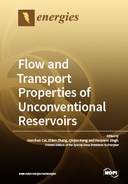Explore

Flow and Transport Properties of Unconventional Reservoirs 2018
0 Ungluers have
Faved this Work
Login to Fave
Unconventional reservoirs are usually complex and highly heterogeneous, such as shale, coal, and tight sandstone reservoirs. The strong physical and chemical interactions between fluids and pore surfaces lead to the inapplicability of conventional approaches for characterizing fluid flow in these low-porosity and ultralow-permeability reservoir systems. Therefore, new theories and techniques are urgently needed to characterize petrophysical properties, fluid transport, and their relationships at multiple scales for improving production efficiency from unconventional reservoirs. This book presents fundamental innovations gathered from 21 recent works on novel applications of new techniques and theories in unconventional reservoirs, covering the fields of petrophysical characterization, hydraulic fracturing, fluid transport physics, enhanced oil recovery, and geothermal energy. Clearly, the research covered in this book is helpful to understand and master the latest techniques and theories for unconventional reservoirs, which have important practical significance for the economic and effective development of unconventional oil and gas resources.
This book is included in DOAB.
Why read this book? Have your say.
You must be logged in to comment.
Rights Information
Are you the author or publisher of this work? If so, you can claim it as yours by registering as an Unglue.it rights holder.Downloads
This work has been downloaded 417 times via unglue.it ebook links.
- 58 - pdf (CC BY-NC-ND) at Unglue.it.
Keywords
- 0-1 programming
- analysis of influencing factors
- analytical model
- carbonate reservoir
- chelating agent
- clay mineral composition
- clean fracturing fluid
- coal deformation
- complex fracture network
- conformable derivative
- contact angle
- deep circulation groundwater
- dissolved gas
- effective stress
- enhanced geothermal system
- enhanced oil recovery
- equilibrium permeability
- experimental evaluation
- extended finite element method
- faults
- finite volume method
- flow regimes
- flow resistance
- fluid transport physics
- fluid-solid interaction
- fractal
- fractal dimension
- fractal geometry
- fractional diffusion
- fracture continuum method
- fracture diversion
- fracture network
- fractured well transient productivity
- fracturing fluid
- gas adsorption capacity
- geothermal water
- global effect
- Groundwater flow
- History of engineering & technology
- hydraulic fracturing
- imbibition front
- imbibition recovery
- influential factors
- integrated methods
- Isotopes
- large density ratio
- Lattice Boltzmann method
- local effect
- low-salinity water flooding
- Lucaogou Formation
- matrix-fracture interactions
- matrix–fracture interaction
- micro-fracture
- mudstone
- multi-scale flow
- multi-scale fracture
- multiporosity and multiscale
- nanopore
- nitrogen adsorption
- NMR
- non-equilibrium permeability
- non-linear flow
- Permeability
- petrophysical characterization
- pH of formation water
- polymer
- pore network model
- pore structure
- pore types
- Porous media
- prediction by NMR logs
- production simulation
- productivity contribution degree of multimedium
- pseudo-potential model
- recovery factor
- remaining oil distributions
- reservoir classifications
- reservoir depletion
- rheology
- Shale
- shale gas
- shale gas reservoir
- shale permeability
- shale reservoirs
- slip length
- spontaneous imbibition
- SRV-fractured horizontal well
- succession pseudo-steady state (SPSS) method
- sulfonate gemini surfactant
- Technology, engineering, agriculture
- Technology: general issues
- temperature-resistance
- the average flow velocity
- thickener
- tight oil
- tight oil reservoir
- tight reservoirs
- tight sandstone
- tight sandstones
- unconventional reservoirs
- velocity profile
- viscosity
- volume fracturing
- well-placement optimization
- wetting angle
Links
DOI: 10.3390/books978-3-03921-117-3Editions


